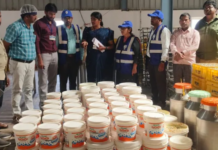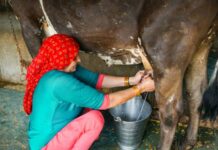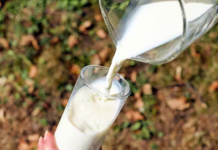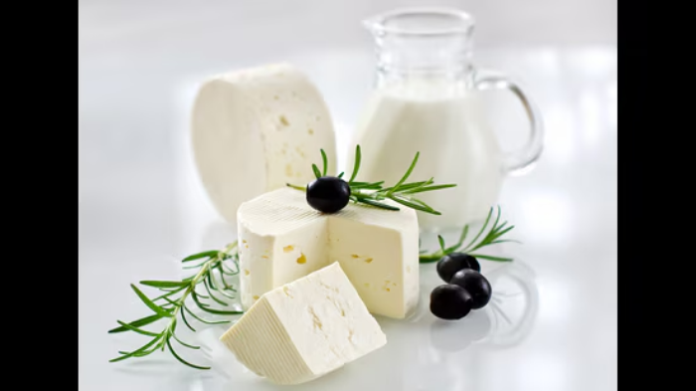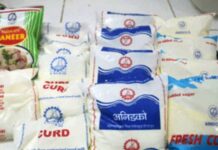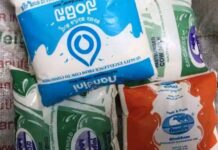New Delhi, September 21, 2024: Nearly half of all dairies in India, the world’s largest milk producer, fall in the unorganised sector and adulteration of ghee or clarified butter, a traditionally valued fat, is rampant, experts have said. Checks to ensure quality, they said, are irregular and often difficult.
A vast informal network makes it easy for unorganised milk processors, who turn the liquid into value-added items such as ghee, chenna (a type of fresh cheese) and paneer (cottage cheese) to dodge inspections, a responsibility of state food inspectors.
According to the government’s Economic Survey of 2021-22, of the total milk produced in rural areas, the marketable surplus is nearly 52%. Of this, “less than half of the milk sold is handled by the organised sector comprising dairy cooperatives and private dairy enterprises, while the rest is handled by the unorganised sector”, the survey stated.
On Friday, a political controversy broke out over alleged reports of adulterated laddus (a ghee-based sweet) used as “prasad” or food offered to deities and then distributed among devotees at Tirumala Tirupati, a widely revered Hindu temple in Andhra Pradesh.
What caused outrage was that the laddus were allegedly spiked with beef tallow, fish oils and other animal-origin lards, prompting federal and state-level investigations.
In 2022-23, the country’s milk production was a world-beating 231 million tonne, spurred by a compound annual growth rate of 6% over the past decade.
Although total milk output in the country has soared on the strength of a well-oiled cooperative sector, productivity continues to drag because the largest chunk of producers are small farmers. Tapping into increasing demand for milk and milk products, informal supply chains abound, mostly under the radar.
“It is very easy to adulterate ghee. Adulteration of loose unbranded ghee from unreliable sources is common, despite well-organised and reputed large branded manufacturers,” said RS Khanna, an international dairy consultant and the chairman of Kwality Ltd, the country’s fastest growing private-sector dairy firm according to the reports published in hindustantimes.com.
In January, authorities from the food and drug control administration in Gujarat, India’s dairy hub, seized 3,000kg of highly adulterated ghee and another 10,000kg still in the production process from a processing plant in Navsari.
Tests showed the presence of animal-origin lard and palm olein, a derivative of palm oil, besides other impurities. Adulteration-free milk products were in fact scarce before the country’s white revolution of the 1970s, a dairy development programme that turned India from a milk-deficient country to a surplus one. It created a national milk grid by linking millions of farmers.
In 2022, in one of the biggest hauls, officials in Karnataka broke into a well-organised supply network of spurious milk products in Tumkur district, seizing 12,000kg of various types of semi-processed milk-based raw materials meant for making sweets. These were later found to be adulterated with various types of vegetable oils and soy.
The milk supply chain consists of farm-gate milk collection centres from which the liquid goes to temperature-controlled chillers, which hold the produce until it is transported to processing plants in insulated trucks by the shortest possible route.
Efficient machinery first separates the cream from the milk. Then, the cream is stirred vigorously to separate the butter from the buttermilk. It is at this step that most adulterants are added. The butter is then clarified by heating, converting it into ghee. Clarification is a process which removes all remaining impurities. The final products then move to distribution centres, including pasteurised milk.
“Branded products are periodically checked. Dairies are required to maintain a large number of records, from start to finish,” said RG Chandramogan of Hatsun Dairy, the largest dairy firm in south India.
Authorities have approved several standard tests to check the purity of clarified butter and milk. Most states rely on what is known as the Reichert-Meissl (RM) value, an indicator of how much volatile fatty acid can be extracted from a particular fat. In 2011, the Food Safety and Standards Authority of India (FSSAI), the top regulator and a wing of the health ministry, prescribed a minimum RM value of 21- 28.
Authorities also use the kit-based Furfural and Baudouin tests, which detect the presence of hydrogenated, plant-based and animal-origan fat in ghee.
In 2019, the FSSAI approved a new cheaper and easier method called the Reversed Phase-High Performance Liquid Chromatography, according to Ajay Mohan, the principal dairy scientific officer at Sun Agro Ltd.
“No matter what the technology, effective prevention of adulteration is ultimately a result of strict law enforcement and greater consumer awareness,” said Pradeep Rai of Shashakt Grahak Abhiyan, a consumer rights NGO.




